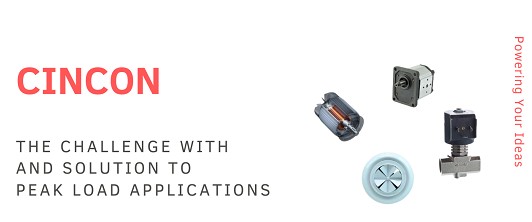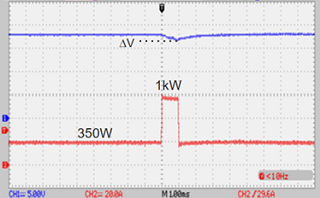What is peak load?
Peak loads in systems are often caused by capacitive and inductive loads. Capacitive loads arise from the presence of large, smooth capacitors in the system, which require a larger amount of current when the power is initially turned on due to their inherent characteristics. On the other hand, inductive loads result from components with inductive parameters, utilizing electromagnetic induction. These loads cause the current to lag behind the voltage, leading to a significant current demand during startup. The waveform of such peak loads shown below is commonly observed in applications with electromechanical motors, pumps, fans, and solenoids.
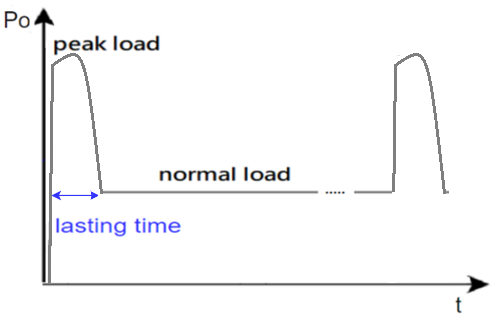
Why to use a power supply with peak power capability
For the most part, the peak power demanded by these applications is significantly greater than the rated power. As the power supply cannot maintain an output current exceeding the normal level for a long period, it might trigger the Over-Current Protection (OCP). However, it is possible to supply the peak current for short durations, typically ranging from microseconds to seconds, with low duty cycles.
Traditional power design would require the system engineer to design the system based on the maximum required power, leading to the system’s size, weight, and cost being determined by the peak power demand. As power density increases, system engineers would face significant challenges in staying within space or weight constraints.
To overcome these challenges, an alternative way involves designing the power supply around the average power requirement rather than the peak power. This approach helps prevent excessive design constraints. However, it is crucial to ensure that the average power drawn by the system remains below the rated power capacity of the power supply. Here is the example:
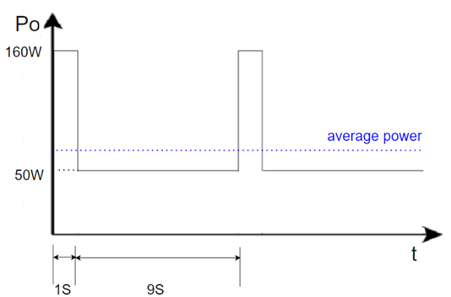

In this case, we can choose CINCON’s CFM81S with 160W peak power capability, rather than a 160W power supply.
How to choose a right solution to peak load applications
In general, the peak load duration ranges from several milliseconds to seconds. The peak load demand can be categorized into two types based on its duration:
1. Peak power for several milliseconds
To address the challenge of delivering a peak current lasting several milliseconds when the power supply is not designed for such demand, the simple solution, for example in this case, is using the CFM500M180 along with a capacitor to meet the peak power requirements. However, when configuring this power system, the engineer must consider the power supply’s maximum capacitive load and adjust the capacitor appropriately to ensure the voltage drop at the load remains within acceptable tolerances.
For instance, in a scenario where the peak load demands 1kW and lasts for 1ms, while the normal operation needs only 300W, the traditional approach would be to configure the power supply for the full 1kW, despite the average power being significantly lower. By contrast, the proposed approach proves successful by utilizing a 500W power supply combined with an additional capacitor to meet the 1kW peak load demand as illustrated below.
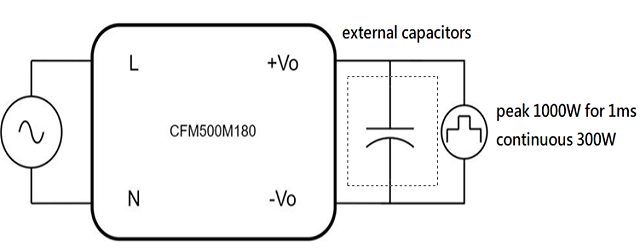

∆V: allowable voltage drop
Ip: peak current
In: normal current
C: capacitance of external capacitor
|
without external capacitor |
with external capacitor(28600uF) |
2. Peak power for several seconds
Some manufacturers specialize in designing power supplies explicitly tailored to deliver substantial peak currents. These power supplies are capable of providing a peak current ranging from 200% to 300% of their rated current for short periods without triggering the over-current protection. Cincon provides a series of power supplies with the peak power capability (200%) for 10 seconds from 25W to 80W. The table shows the product combination:
| Series | CFM25S | CFM41S | CFM61S | CFM81S |
| package | 2”X1″ | 2”X2” | 2”X2” | 2”X3” |
| Rated power (continue) | 25W | 40W | 61W | 81W |
| Peak power (10 seconds) | 50W | 80W | 120W | 160W |
| Safety approval | 62368-1 60335-1 |
62368-1 | 62368-1 | 62368-1 60335-1 |
Additionally, as the majority of Over-Current Protection (OCP) set points are set at approximately 140% of the rated current, certain power supplies are designed to offer an extra 20% power (below the OCP threshold) for several seconds. This design helps prevent the activation of the over current protection. The table below shows Cincon AC/DC power supplies with peak power capability (120%) for 5 seconds from 130W to 500W.
| Series | CFM130S | CFM150S | CFM260S | CFM500S/M |
| package | 2”X3″ | 2”X4” | 2”X4” | 3”X5” |
| Rated power (continue) | 130W | 150W | 260W | 500W |
| Peak power (5 seconds) | 156W | 180W | 312W | 600W |
| Safety approval | 62368-1 | 62368-1 | 62368-1 | 62368-1 60601-1 |
Conclusion
As smart homes and smart manufacturing continue to advance, numerous electromechanical applications often demand peak currents for short periods. Choosing AC/DC power supplies equipped with peak load capabilities, as opposed to traditional PSUs, brings about several advantages, including reduced volume, lower costs, and decreased weight. Cincon provides a range of power supplies designed specifically to meet peak power demands. When developing these power supplies, we carefully consider the intended load requirements.
If you require assistance with a peak power project, please don’t hesitate to reach out to us. We would be delighted to discuss your requirements and address your specific needs. Contact: office@vitecpower.com

